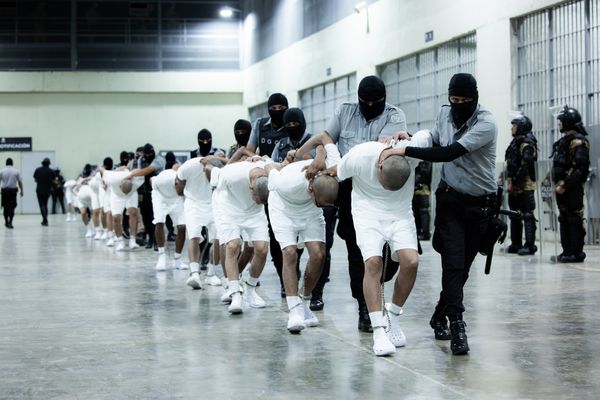CHICAGO — A filmmaker plays fly on the wall to the world’s biggest pop stars.
Gathering mountains of footage, some of it revealing, nearly voyeuristic.
And so, for myriad reasons, it goes unwatched, for many, many years.
That’s true of Peter Jackson’s “The Beatles: Get Back,” which debuted in November, assembled from hours of material that director Michael Lindsay-Hogg shot in early 1969, capturing both the recording of “Let It Be” and the splintering of the group itself.
But that’s also true of “jeen-yuhs: A Kanye Trilogy,” which unfolds over three episodes on Netflix this month. It’s constructed of years’ worth of footage that Chicago filmmaker Clarence Simmons — with directing partner Chike Ozah, credited as Coodie & Chike — gathered of Kanye West in the nascent days of his career. If “Get Back” documents a season of unease, dissolution and hurt, “jeen-yuhs” is a season of promise and hurt.
But mostly, these are films about creating.
As in, the physical labor.
These are not movies about personalities or internal disputes or the cost of fame or hollow claims of greatness, but rather what it takes to sit down and get something made. The grind, the hard part, the day-to-day ups and downs it took to create the music of the Beatles and Kanye West. Both films will be discussed for years, for endless reasons, but their value has less to do with breakups, breakdowns or biographical insights than a forensic patience, a willingness to watch and watch, then watch some more, that most mysterious of qualities — creativity. Which means, both films are long. Collectively, they’re about 12 hours, though not because they’re long-winded. But because watching creative people actually make something — that’s rarely fast, inspiring, pretty, obvious.
Or sensical.
I had a friend who taught film school. For years, the first thing his freshman had to do was watch “Ed Wood,” Tim Burton’s beautiful 1994 portrait of the Worst Director in History. He did this because it was a reminder that vision and talent are only part of being creative. What if you don’t have talent, ideas or even competency? Does creativity only belong to the successful? Should you stop? The truly creative soldier on, and the Ed Wood in that movie (played by Johnny Depp, with boundless optimism) is all headlong momentum, even as everyone working with him sighs and groans and doubts.
In Quincy Jones’s upcoming memoir, “12 Notes: On Life and Creativity,” he remembers his South Side childhood and routinely climbing through the window of a rec center to play its piano. “I tried to mimic sounds I had heard at the old Baptist church I attended. ... But when I ran out of tunes that I could remember, I resorted to playing whatever I was feeling.” In Bob Odenkirk’s “Comedy, Comedy, Comedy, Drama,” another upcoming, locally minded memoir, a former girlfriend recalls, back when he was writing comedy and roving show to show, Chicago to Los Angeles, his single-minded “super focus did not help build a relationship.” Let’s not confuse obsessiveness and drive with creativity, but they do live in the same cul-de-sac.
I swear, for the first three hours of “jeen-yuhs,” Kanye West is never shown relaxed, just sitting back. He is always restless, moving, hunched in chairs, at mixing boards, at home, T-shirts and takeout containers strewed about because he only works, to the eventual (and infamous) detriment of everything in his life. Yet in some of the film’s most charming moments, before he’s even recorded an album, he’s shown barreling through record companies, popping CDs onto the nearest trays and rapping for whomever happens to be in the room. It’s not just that he’s a man in need of a stage, but that, in a more pragmatic sense, he’s testing new material on anyone around — he’s fine tuning.
I have a thing for this, for art that captures the boring stuff about art.
Also known as, making art. Still, I like to see the coming-together, I like to watch the sausage getting made. I love the tedium. So do you. Some of the most popular videos on TikTok and YouTube are basically industrial films — assembly-line tourism, a box being constructed, a candy cane being forged. Even the best season of “Curb Your Enthusiasm” was less about the headaches and arguments that led to a new, improved “Seinfeld” finale, than about a million little conversations, casting decisions, promises.
The salacious, heated stuff usually bundled into showbiz memoirs, Oscar biopics and narrative works about the creation of art and rise of great artists — I like that, too. Those ubiquitous documentaries that purport to dig behind the music — it’s fine, it’s fun. (Yes, I plan to watch “Pam & Tommy.”) But that’s another breed. I’m talking about films and books that approach creativity like it’s Take Your Audience to Work Day. Which, of course, require some degree of renown and hubris to even expect attention. Lillian Ross’s “Picture,” her classic 1952 nonfiction account of the making of “The Red Badge of Courage,” wouldn’t have been possible if John Huston wasn’t on a historic roll — “Maltese Falcon,” “Treasure of the Sierra Madre,” “Asphalt Jungle,” boom, boom, boom — begging for documentation. The popular podcast Song Exploder is at its best when exploring the dull, practical decision-making from artists who wallpaper our world — Common, U2, Metallica. “All That Jazz,” Bob Fosse’s 1979 semi-autobiographical film isn’t about inevitable success, but make-up tests, rehearsals, writing, thinking; only after that is it also a dramatization of Fosse editing the film “Lenny” while staging the play “Chicago.”
Again, there’s a degree of hubris in assuming we might care.
“Get Back” takes this to a logical extreme: If you could spend hours in the studio just watching any recording act in history, the Beatles would be a lot of people’s first choice. Which even the Beatles knew when they gave permission for a filmmaker to capture nothing much: songs endlessly retooled, late-day exhaustion, piano plinks that evolve into classics, Paul strolling into work in the morning, everyone wondering what’s for lunch and many, many thousand yard stares that (knowing what we know now) look like the earliest glimmers of “Band on the Run,” “Imagine” and “All Things Must Pass.”
Like any historical document, “Get Back” seems to hold both the past and the future at once. Jackson’s film may be the most intimate portraits of creativity we have because it is so willing to present us with nothing much at all. Just that boring struggle to create.
In “jeen-yuhs,” Kanye West — who just had his name legally changed to Ye — is so certain of his creative importance, it’s an ongoing joke among friends that Coodie is following him before anyone knows him. But Kanye has good instincts here. So does Coodie — a Chicago stand-up with aspirations of making a music industry take on “Hoop Dreams.” He captures dental appointments. He finds Kanye at parties where everyone is socializing but Kanye is off by himself, focused and working on his record. Odds were, Coodie would be gathering material for a “Hoop Dreams”-like portrait of disappointment. Of course, he got the opposite. About midway through “jeen-yuhs,” the footage, and story, changes, feels more familiar. There’s success, then, inevitably, the creep of peak Kanye cringe looming, and so we watch, again, the kind of material that will eventually, some day, find its way into an Oscar biopic. George Bush not liking Black people, Taylor Swift, that 2020 presidential run, Donald Trump, all those Kardashians.
For nearly three hours, “jeen-yuhs” avoids the worst of Kanye West by avoiding the downfall that movies about artists eventually turn toward. But then, it also never becomes the cheap flurry of headlines and poetic montage of dramatic creating that tar movies about artists. Even after the craziness takes center stage, Kanye is rarely shown not creating. He’s forever the one leaning in, finishing a song, going over a design for his fashion line, sketching out ideas for artist Takashi Murakami to work onto new album covers. There’s a Fellini-esque swirl late in the documentary, at Kanye’s ranch in Wyoming, a large sound studio-like warehouse, not unlike the one in “Get Back.” Justin Bieber is recording a refrain in the next room. A live band is tinkering on a small stage. A Kurosawa film is being projected behind them. Meanwhile Kanye is on the phone with producer Rick Rubin, discussing a visit to the studio of sculptor Tina Frey.
Maybe that’s Warhol-esque swirl.
By this point in the film, though, Kanye is so popular and impenetrable, Coodie doesn’t have the access he once did. And access is the key to many great works about creating art. Which is why intimate ones are so rare. I often tell friends to read Julie Salamon’s “The Devil’s Candy,” a painstaking 1992 book about the disastrous making of Brian De Palma’s “Bonfire of the Vanities,” but I always add a sad reminder that the access she had to that production was remarkable in the early ‘90s, too. As much as Hollywood likes to sell the dream factory stuff, a film like Robert Altman’s “The Player” is so blunt about how sausage actually gets made — “It’s ‘Out of Africa’ meets ‘Pretty Woman!’” — there’s a protective urge to stick with the cheap flurry of headlines and poetic montages.
Coodie tells us in the narration that as Kanye takes off, he asks Coodie to back off. He tells the filmmaker that he’s playing a role now, and all that earlier stuff, that’s too real.
Ironically, it’s now a humanizing portrait of an artist who could use some salvation from caricature and persecution — self-inflicted and not. You want to know what it’s like to be an artist? Watch Kanye stand in the street outside a record company, trying to catch a second with an executive. Hear an A&R guy ask, with implied mockery, how Kanye’s record is coming. Kanye was not an artist then but a producer, with a reputation for being meticulous, arrogant and self-doubting. “It’ll never be finished,” Kanye said softly.
He’s not lying.
We watch him reworking lines, beats, cadences, phrasing, adjusting, head down, burying himself inside the work for long periods, adjusting again. He describes Jay-Z’s recording process as: bunch of rappers come to the studio, a week later the guy leaves with a new record. He says it with a laugh and a hint of jealousy. He can’t leave well enough alone. The second of the three films begins with his 2002 car accident in Los Angeles, then finds Kanye, six weeks later, in a hotel room, jaw nearly wired shut, still working, the room a landfill of recording gear, song outlines, half-eaten meals. Among the many things “jeen-yuhs” is saying about creativity is the need for support, mental and otherwise, and for a long time, his mother leads that charge. She is his perspective.
One of the film’s most touching scenes is a late-night visit to Donda West in her Chicago apartment. She tells her son: Stay on the ground and you can be in the air at the same time. He listens, but as with “Get Back,” the circle gets progressively too crowded, too loud. Kanye becomes obsessed with whether he is a genius. Some friends push back.
Not for you to say, they tell Kanye.
To which Kanye says ... nothing, not at first. Why bother responding? He has a studio of his own. There are scenes in “jeen-yuhs” where more famous rappers grow silent and intimidated by his startling promise. Still, his need for validation remains bottomless. Not a surprise, but one in which Coodie & Chike find room for a more poignant conclusion: Whatever genius is there, whatever work he creates, is inseparable from Kanye, good and bad, arrogant or honest. Speaking of Fellini, it’s nearly a salute to “8 1/2,” itself a portrait of artistic sausage production. Marcello Mastroianni plays a great director whose film is falling apart, until he realizes he is nothing without those who love him. He shuts down production and accepts the failure, because failure, in the end, is part of creation.
———







